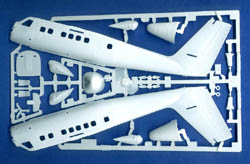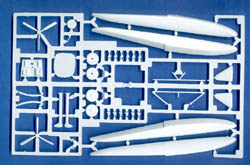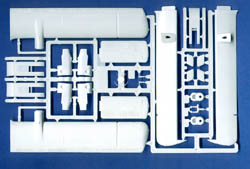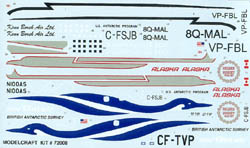Modelcraft 1/72 de Havilland Twin Otter |  |
Overview
"The Twin Otter is back!", will be heard through out hobby shops. Thanks to Modelcraft of Canada we won't be paying those sky high prices on Ebay for these kits anymore. Your first thought, is this a new kit? No, it's a re-issue of the Matchbox. So, follow along with me, as we see what's new inside. The Kit The first thing I noticed is it's a larger, sturdier box. As you remember with the Matchbox kit, it was stuffed like dressing in a Turkey into that flimsy, undersized box. The new box art is well done graphically and should be an eye catcher on the store shelves.  Opening the kit, I was a bit worried that it was going to be molded in the same three awful colors of white, yellow and gray plastic. Happily, they have produced the entire kit in bright white plastic. The molding looks as fresh as the day it was first issued. When was this first made? I remember buying my first Twin Otter kit in the middle 1980's. Al Superczynski, old kit guru here at Internet Modeler said "I don't have an original issue, but my Revell AG release is dated 1989. I don't know the exact year but it was sometime in the early '80s. Revell bought all the kit tooling outright, and the right to use the Matchbox brand name on them for ten years. Revell AG still issues kits from the old Matchbox tooling under their own name." Opening the kit, I was a bit worried that it was going to be molded in the same three awful colors of white, yellow and gray plastic. Happily, they have produced the entire kit in bright white plastic. The molding looks as fresh as the day it was first issued. When was this first made? I remember buying my first Twin Otter kit in the middle 1980's. Al Superczynski, old kit guru here at Internet Modeler said "I don't have an original issue, but my Revell AG release is dated 1989. I don't know the exact year but it was sometime in the early '80s. Revell bought all the kit tooling outright, and the right to use the Matchbox brand name on them for ten years. Revell AG still issues kits from the old Matchbox tooling under their own name."
Modelcraft has redone the original instruction sheet into a more user friendly style of booklet. All the graphics have been expanded and it is now much easier to read. For you newer modelers who haven't seen the kit, one of the great things is, it comes with four versions to be built. You can complete this with long or short noses, wheels, skis or on floats. Looking closer at the model, it has very little if any flash and very minor sink holes.  Interior Interior
The cockpit includes all flooring, bulkheads, seats, an overhead panel and an instrumented dash. The dual yoke and column is also included, but is slightly too tall. It should only come up to the middle of the dash. A cut at the floor boot is a quick fix. The kit does not come with any seats for the passenger compartment. The windows are single pieces and are very clear. Exterior  Outside, the kit has both raised and recessed panel lines. All the flying surfaces are very well done with the corrugated panels and trim tabs. If you are doing a wheeled version, remember to sand off the finlet mounting locating marks on the stabilizers. There are only two very minor things I would correct on this fine kit. First, the prop blades need to be twisted 90 degrees. The blades go into feather on the PT-6 engines during shutdown. The blades could also use some slight profile sanding. Second, the stall fence on the upper wing could be sanded thinner or replaced with thin plastic stock. Overall, I am pleased with the total execution of this kit. Outside, the kit has both raised and recessed panel lines. All the flying surfaces are very well done with the corrugated panels and trim tabs. If you are doing a wheeled version, remember to sand off the finlet mounting locating marks on the stabilizers. There are only two very minor things I would correct on this fine kit. First, the prop blades need to be twisted 90 degrees. The blades go into feather on the PT-6 engines during shutdown. The blades could also use some slight profile sanding. Second, the stall fence on the upper wing could be sanded thinner or replaced with thin plastic stock. Overall, I am pleased with the total execution of this kit. After five rolls of film shot on a local Twin Otter, I can say that everything on this kit is very accurate. The bottom line here is, it looks just like the Twin Otter. Decals  If the treat of the reissue isn't enough, there are five new colorful paint schemes included. Apollo decals did the new art work which include: If the treat of the reissue isn't enough, there are five new colorful paint schemes included. Apollo decals did the new art work which include: Norontair Loon scheme
British Antarctic Survey
US Antarctic Program
Maldivian Air Taxi
Alaska Golden Nugget The sheet is the standard silk screened type. It looks really good and should be one of the main selling points of the kit. I was interested in how the striped props were going to be handled. You'll find twelve sets of blocks of black and white squares. The modeler will paint the one side of the blade, say, white and then apply the black blocks to the blade. The strange thing with this is, the front and the back are different patterns- front is opposite of the back. What's even stranger is that this pattern is for ONLY two of the three blades, the third is backwards of the other two! To see what I'm talking about, take a look at the photo at airliners.net. This striping pattern seems to be on most of the Kenn Borek planes. You'll also notice the pilot in this photo kept the props in manual, for parking control and are not in feather. Two small concerns on the sheet. There was a slight shift in registration of the white ink. This shows up on the borders on the flags. Second, and I'm nit picking here, on the Alaska Golden Nugget scheme, the Twin Otters didn't use the red trim on the gold tail circles. They also used a thinner text on their logos. I don't fault the designer on this. The problem is there are only a very few good quality photos of these planes. I have several Kodachromes of N100AS and N711AS, so I can speak with some expertise. 
Overall, I'm quite happy with the decal sheet. If these schemes don't float your boat, additional sheets are available from DRAW Decals, Aerocolors/Flightpath, Liveries Unlimited, JBOT and Flight Designs. Conclusion I must applaud Modelcraft for bringing back this work horse. I would recommend the kit with a 9 out of 10 rating. This kit is not only for the civil or airline builder, the Twin Otter was used by various militaries in high and low visibility schemes. Now you won't have any excuses to not build this kit. There are so many options available, you would be hard pressed to not be pleased with Modelcrafts' new offering. Many thanks to Modelcraft for this sample. You can see their other fine models at their website. | 








|
